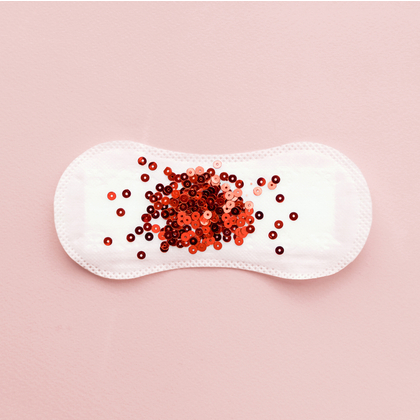
During the perimenopause, your oestrogen and progesterone levels fluctuate, which has a knock-on effect on ovulation and your menstrual cycle. As hormone levels vary month-on-month, you’ll likely notice that your periods become irregular, heavier or lighter than usual, or that you sometimes miss a period.
This is a normal part of the process of reaching the menopause, and while it will be different for every woman, there are certain things to be aware of when it comes to perimenopausal bleeding and spotting.
How does the perimenopause impact your periods?
In your peak reproductive years, levels of your reproductive hormones oestrogen and progesterone rise and fall somewhat consistently throughout your menstrual cycle. When you enter the perimenopause, however, your ovaries stop ovulating regularly.
Since ovulation is more infrequent than before, circulating levels of oestrogen and progesterone become unpredictable and erratic, which can result in unusual bleeding patterns.

Irregular periods during the perimenopause
In light of your fluctuating hormones, your cycles may be irregular and fall outside the traditional 28-35-day window. The time between your periods may also vary on a month-by-month basis.
Though this can be disconcerting and make everyday life difficult, try to remember these changes eventually cease.
You may consider investing in period underwear or wearing black knickers to reduce the risk of spoiling clothing. Disposable panty liners can also help to protect from irregular leaks, and some women find period tracking apps useful.
Shorter cycles
When circulating amounts of oestrogen are low, your uterine lining is thinner, which can lead to lighter and shorter menstrual cycles. Shorter cycles are more likely to occur in the earlier phase of the perimenopause.
Longer cycles
In the latter stages of the perimenopause, you may have much longer cycles (typically longer than 36 days) and go four to five weeks without menstruating. Usually, these cycles are anovulatory, meaning you don’t ovulate.
Missed cycles
You may miss a cycle altogether, due to hormonal fluctuations. You may even struggle to recall the last time you menstruated. Remember, you only officially enter the menopause when you haven’t had a period for 12 months.
You don't have to worry too much about missed cycles. But it’s important to remember that, as long as you’re having cycles — no matter how regular — you are still ovulating and can get pregnant. If you’ve missed several consecutive cycles, you may want to take a pregnancy test to be sure.
Heavy periods and flooding during perimenopause
Alongside changes in regularity, you may notice your period is heavier than usual. Before the perimenopause, your ovaries secreted oestrogen to thicken the lining of the womb. Once the ovaries released the egg, they produced progesterone.
The synergetic relationship between oestrogen and progesterone ensured your periods weren’t too heavy or light. However, as you enter the menopause, ovulation becomes more sporadic, even though your ovaries continue to secrete oestrogen. Since there isn’t enough progesterone to stabilise the effects of oestrogen, you may experience heavier periods.
Some perimenopausal women can experience extremely heavy periods with ‘flooding’, medically known as Perimenopausal Dysfunction Bleeding (DUB). In this, bleeding can be so heavy that sheets or seating become soaked with blood when lying or sitting down.1 Naturally, this can interfere with your everyday life.
Though heavy bleeding is common during the menopause, you shouldn’t ignore it. We recommend discussing this with your GP.
What causes perimenopause spotting?
Spotting refers to any light bleeding outside your usual menstrual window. As the name suggests, you may find small spots of red or pink blood in your underwear or when you go to the loo. Spotting doesn’t usually require sanitary protection.
Generally speaking, spotting is the result of your body’s changeable hormones and endometrium (the lining of your uterus) build-up. Many perimenopausal women spot just before their period starts or as it ends. On occasion, you may also spot in the middle of your cycle when you ovulate.
Although some spotting is normal, if you’re regularly spotting every fortnight — or, in some cases, every day of the month — you may want to speak to your GP.
When to speak to your GP
While menstrual irregularities are nothing unusual in the perimenopause, some abnormal bleeding patterns may signal deeper health issues and warrant getting a medical opinion. Talk to your GP if you notice the following:
-
You experience very heavy menstrual bleeds or ‘flooding’, particularly with clots. A useful marker is if you soak through sanitary protection every hour for more than a day. Besides the obvious inconvenience, heavy periods may also lead to anaemia due to low iron, resulting in extreme weakness and fatigue.
-
You have several cycles in which your period lasts longer than seven days.
-
You experience bleeding that occurs more frequently than every three weeks.
-
You regularly experience spotting.
-
You bleed after having sexual intercourse.
It’s also important to note that bleeding after reaching the menopause (when you have not had a period for 12 consecutive months) can be a sign of something in itself, and should be treated as a separate issue.
We understand that this stage of your life can be distressing, and there is a lot of conflicting advice out there about the menopause and how to manage it. The most important thing to remember is that it will be a totally personal experience, and you shouldn’t hesitate to discuss any of your concerns with your doctor or loved ones.
If you want to learn more about managing your perimenopausal and menopausal health, explore the rest of our Menopause hub.
References:
-
Acog.org. 2020. Perimenopausal Bleeding And Bleeding After Menopause. Available online: https://www.bssa.uk.net/pdfs/information-sheet.pdf
Other Sources:
-
Harvard Health. 2020. Abnormal Uterine Bleeding In Peri- And Postmenopausal Women - Harvard Health. Available online: https://www.health.harvard.edu/womens-health/abnormal-uterine-bleeding-in-peri-and-postmenopausal-women
-
Mayo Clinic. 2020. Perimenopause - Symptoms And Causes. Available online: https://www.mayoclinic.org/diseases-conditions/perimenopause/symptoms-causes/syc-20354666
-
Van Voorhis B.J. et al., The relationship of bleeding patterns to daily reproductive hormones in women approaching menopause. Obstetrics and gynaecology. 2008;112(1):101-108.
Related Posts
Disclaimer: The information presented by Nature's Best is for informational purposes only. It is based on scientific studies (human, animal, or in vitro), clinical experience, or traditional usage as cited in each article. The results reported may not necessarily occur in all individuals. Self-treatment is not recommended for life-threatening conditions that require medical treatment under a doctor's care. For many of the conditions discussed, treatment with prescription or over the counter medication is also available. Consult your doctor, practitioner, and/or pharmacist for any health problem and before using any supplements or before making any changes in prescribed medications.

Christine
Christine Morgan has been a freelance health and wellbeing journalist for almost 20 years, having written for numerous publications including the Daily Mirror, S Magazine, Top Sante, Healthy, Woman & Home, Zest, Allergy, Healthy Times and Pregnancy & Birth; she has also edited several titles such as Women’ Health, Shine’s Real Health & Beauty and All About Health.
View More



